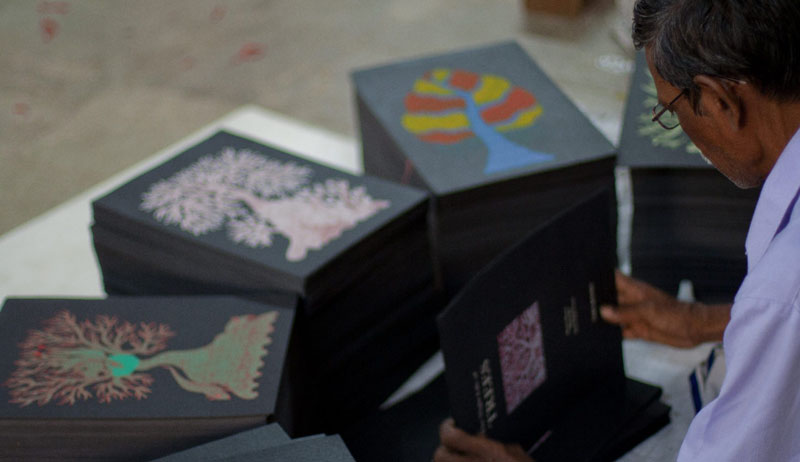
24 Feb Nothing is Impossible: Sustainable Design and Production
by Rathna Ramanathan
From her studio Minus 9 Design, Rathna Ramanathan has worked with Tara Books on projects over the last twenty years. Here, she reflects on her experiences of collaborating with Tara Books in the context of sustainable modes of design and production, and alternative models of publishing.
Jason McLennan in The Philosophy of Sustainable Design summarizes sustainable design as the redefining of how things – objects, buildings etc. – are designed, made and operated to be more responsible to the environment and responsive to people. India is a country that has an excellent tradition in sustainable design and production. Just a glance at Aditi and M P Ranjan’s Handmade in India: A geographic encyclopedia of Indian handicrafts, gives one a sense of the wealth and range of local design and craft processes that are indigenous to our country.
In industrial production processes, sustainability is much harder to achieve as the focus is on achieving the best quality product at the lowest possible price and within the fastest production time. This isn’t always achievable in a local context. In publishing it has become common practice for publishers (particularly in Europe and North America) to send books to print in Asia – particularly China. This is problematic for a few reasons.
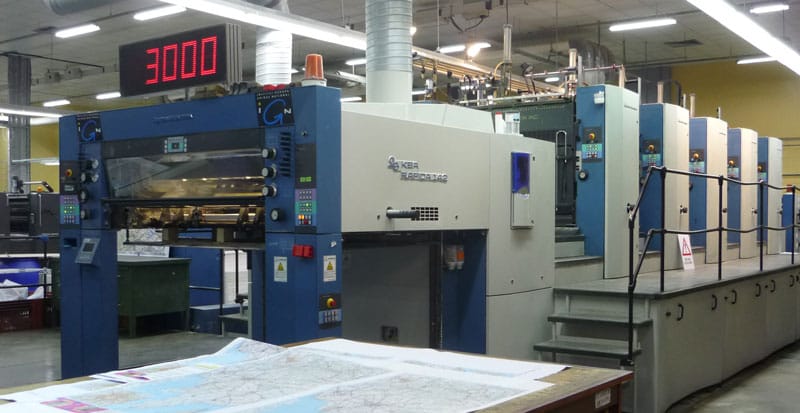
A conventional offset printing press (Source: Wikimedia Commons, Photo by Rémih)
First, is the environmental impact of the lithographic offset process, which traditionally uses masses of chemicals and energy and utilises large amounts of water, paper, aluminium and plastic in the production process.
Second, is the environmental impact of producing goods in faraway locations, requiring them to be shipped back to the countries in which they were designed to be sold.
Third, is the paper often used in the printing of books. ‘Paper pulp production’, as noted by Caroline Clark of lovelyasatree.com, ‘is responsible for a rapid global expansion in intensively managed tree plantations, some of which are established by clearing natural forests or other precious habitats’. Just one ton of recycled paper saves approximately six mature trees and 89 cubic feet of landfill space.
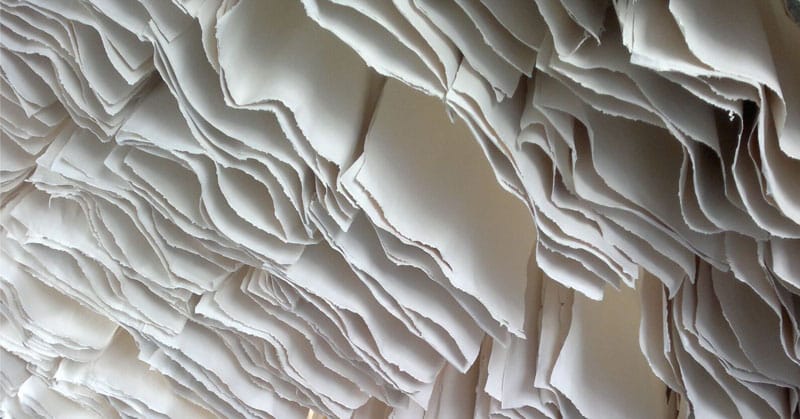
Our handmade screen-printed books use locally made recycled handmade paper
Last but not least, because the designers of the books are invariably not based in the countries printing them there is a break in the production process. This means less time and opportunity for meaningful dialogue or interaction and more automation and impersonalisation. If we take a look at the inside of a book of fiction published by a European publisher or an American publisher, and you will notice that they tend to look almost identical rather than as individually designed objects. In contrast, independent publishers such as Tara Books have an opportunity to pursue more local, sustainable production options.
The Tara Story
I first came to know of Tara Books when they invited me to come by with my design portfolio. This was in 1996 and at the time, the publishing house was still very young and had only one title in print. I was astonished to hear from my classmate that this title – The Very Hungry Lion (currently out of print) written by Gita Wolf and illustrated by Indrapramit Roy – was printed in-house, by hand using the silkscreen process on locally made handmade paper.
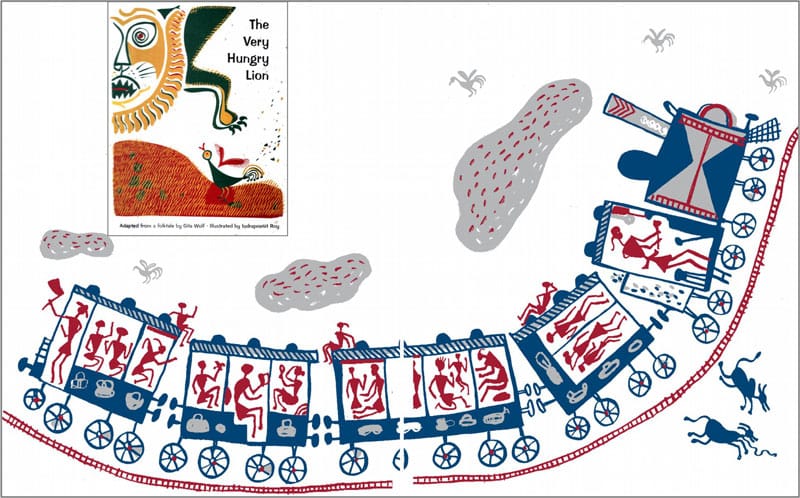
The Very Hungry Lion: our very first handmade book was published in 1996
It was the first time I had ever heard of a publisher producing books in such a different way. My response to hearing that was to wonder whether anyone could sustain such an approach to the making of books. I have worked for Tara as a freelance book designer for close to 20 years now and have come to realise that Tara’s way of doing things is often innovative and path breaking.
The handmade titles published by Tara are produced in Tara’s in-house fairtrade printing shop called AMM Screens after its founder (and Tara’s Production Manager) Arumugam Chinnaswamy. The motto of Tara’s printing workshop – ‘nothing is impossible’ – is a genuine mission.
The Making of Creation: a short film showing the process behind our handmade books
The workshop prints an average of 27,000 books by hand every year, and a staggering total of over 3,50,000 books have been produced as of early 2017. This is no joke in the silkscreen process where each colour has to be ‘pulled’ by hand individually. According to Arumugam, the average number of books made per day is 90 and the number of pulls per book is roughly 75. This makes for a grand total of 2 million and 25 thousand pulls a year! This is incredible when one considers that this is no big scale industry but instead a small self-contained printing workshop of 25 young printers who hail from villages in Tamil Nadu and live and work together in Chennai as a community.
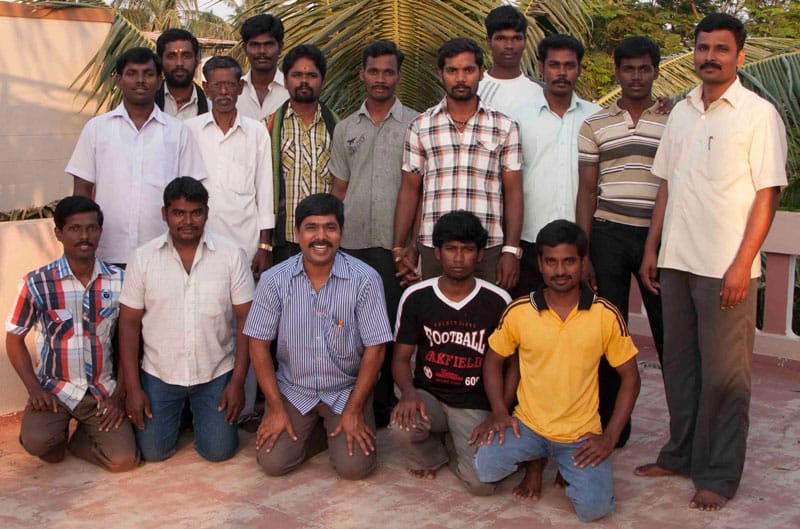
25 bookmaking artisans live and work together in our workshop run according to fair-trade practices
The making of a handmade book
The book production process is built on fair-trade and sustainable values. The paper that the books are printed on is handmade from cotton rags and recycled waste paper. The paper, procured from nearby towns, is ordered exactly to the needs of the project, ensuring no waste. And in fact, any wastage in the process of printing books ends up being a cover for Tara’s stationery range of Flukebooks.
Film used to embed the image on screen is exposed using natural sunlight or single tube light. There are no huge machines being run or mass energy consumed in the process of printing the books. Instead the process from start to finish is by hand. Colours are mixed by hand in large vats, designs positioned on screens and pulled by hand, and dried naturally in the open air in large crated shelving. The individual sheets are then collated into order and stitched by hand.
With publishing, design and production happening in one city, local solutions can be found to problems and unique approaches can be formed to each book. For example, Arumugam recounts how for the book Antigone which had a big print run; cricket bats were purchased to mix the colour in buckets. With The Night Life of Trees, the black handmade paper on which the book was printed on gave the word ‘Night’ to the title. And when the monsoon rains hit during the production of The Beasts of India the books were dried with hairdryers belonging to the Tara team.
Concept and production came together in interesting and unexpected ways in some of our classic titles
Looking to the future
As William McDonough put it, ‘design is the first signal of human intention’. As designers and producers of content, we have the obligation to first ask ourselves before we produce more things to put out into the world. What are our intentions? What values do we wish to propagate? What kind of world are we leaving as a legacy for future generations? The Tara Books model gives voice to the stories of a marginalised people, builds on local talent, materials and processes of production, and is the output not of an anonymous corporation but of a collective of individuals working together. That is a practice that is worth sustaining for present and future generations.
(A slightly modified version of this piece was first published by POOL Magazine)
Designer Rathna Ramanathan has steered the design philosophy of Tara since the very beginning. In the process, she can be said to have pioneered innovative children’s book design in India. Her main interest is in typography as well as in changing the form of the book. She runs minus9, her own graphic design studio, and is currently the Head of Visual Communication at the Royal College of Art, London. Click here to discover Tara Books she has designed.


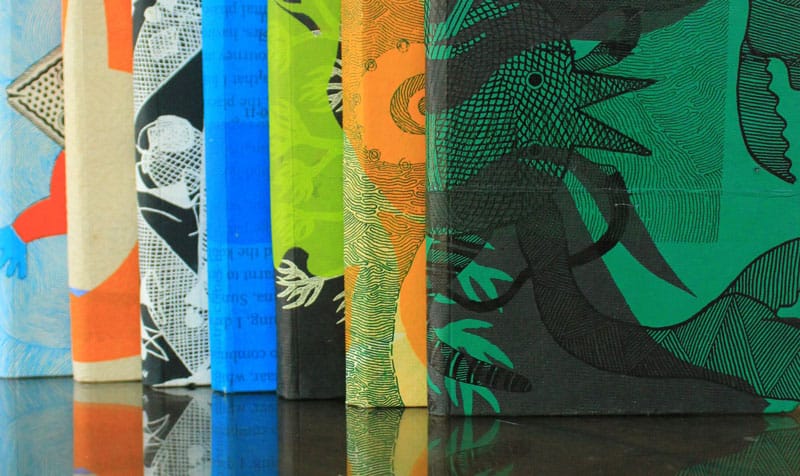
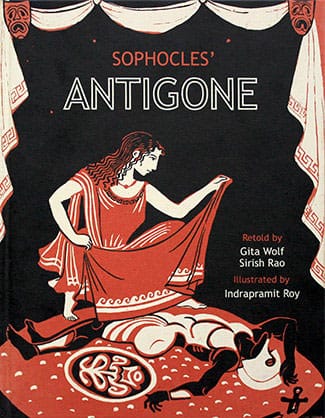

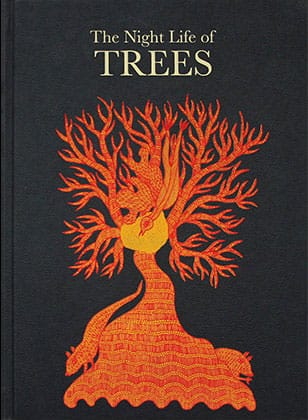

Vivid Kreations
Posted at 18:07h, 29 JanuaryThis post brilliantly explores the intersection of sustainability and design, showing how innovative practices can make eco-friendly production achievable. Inspiring.